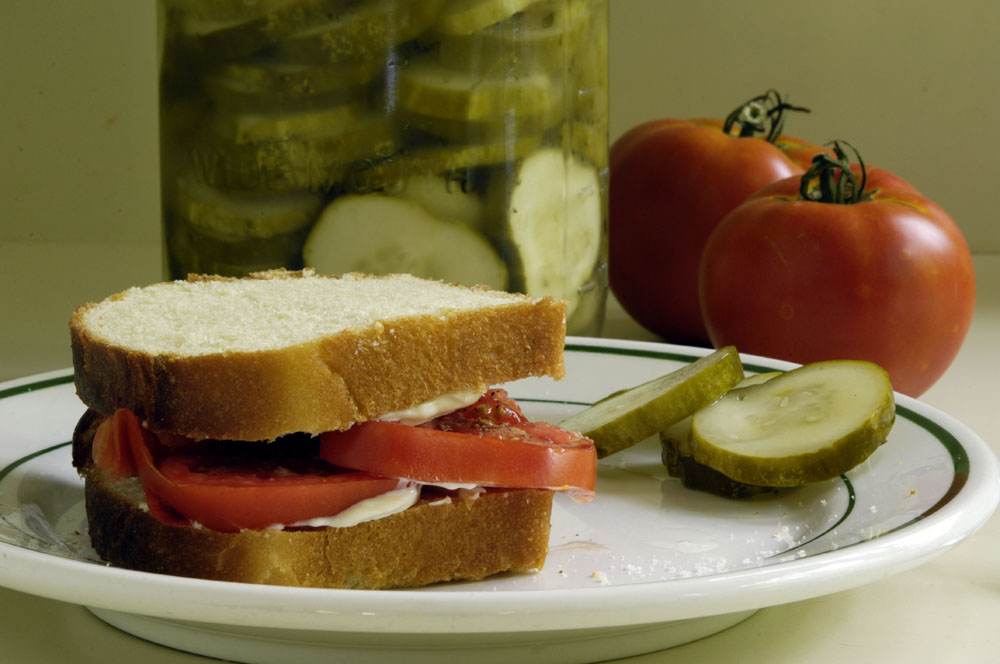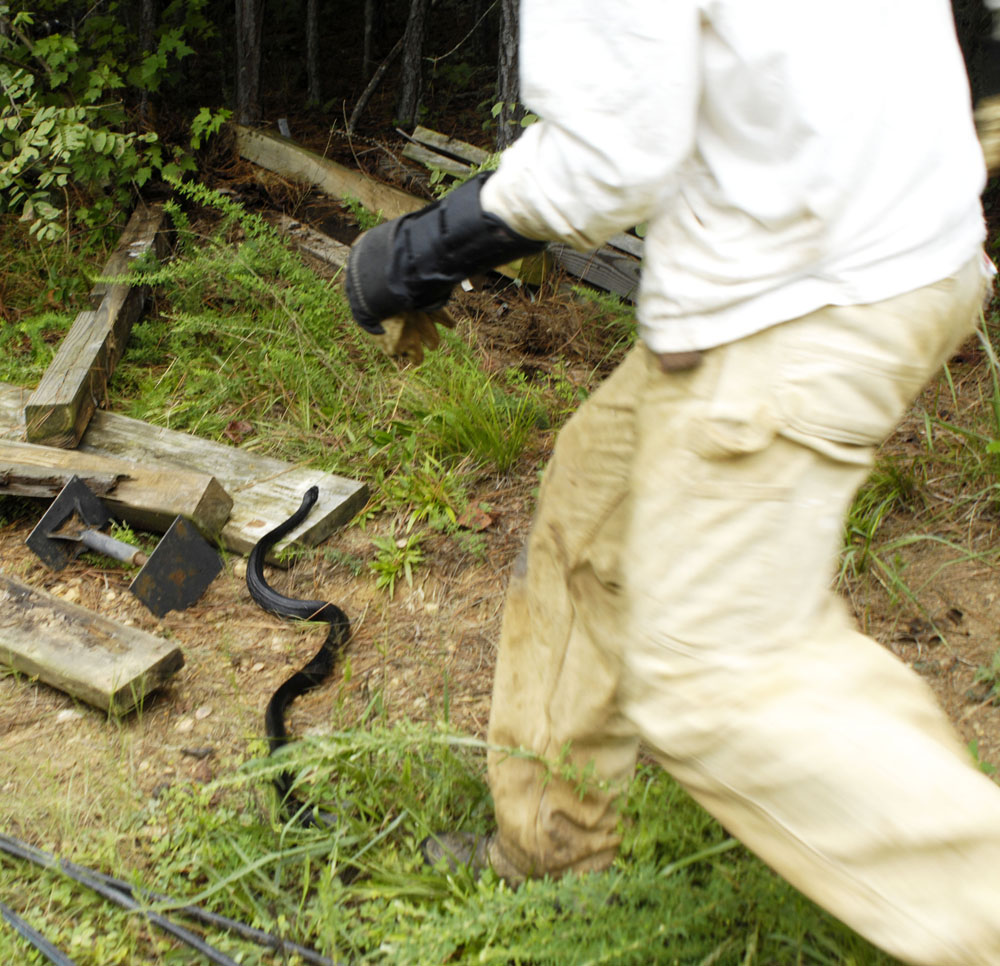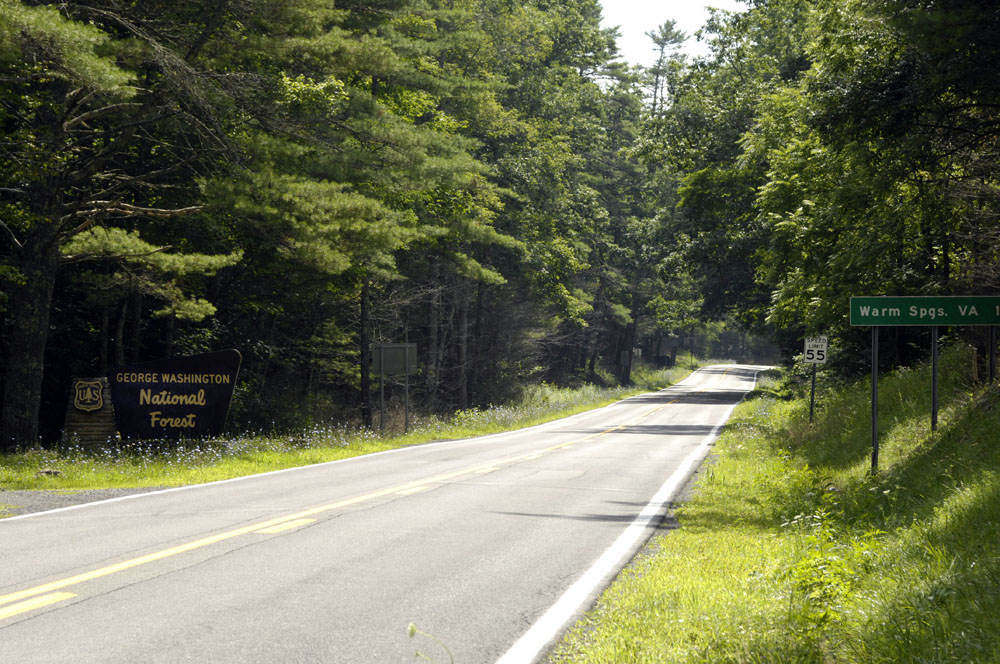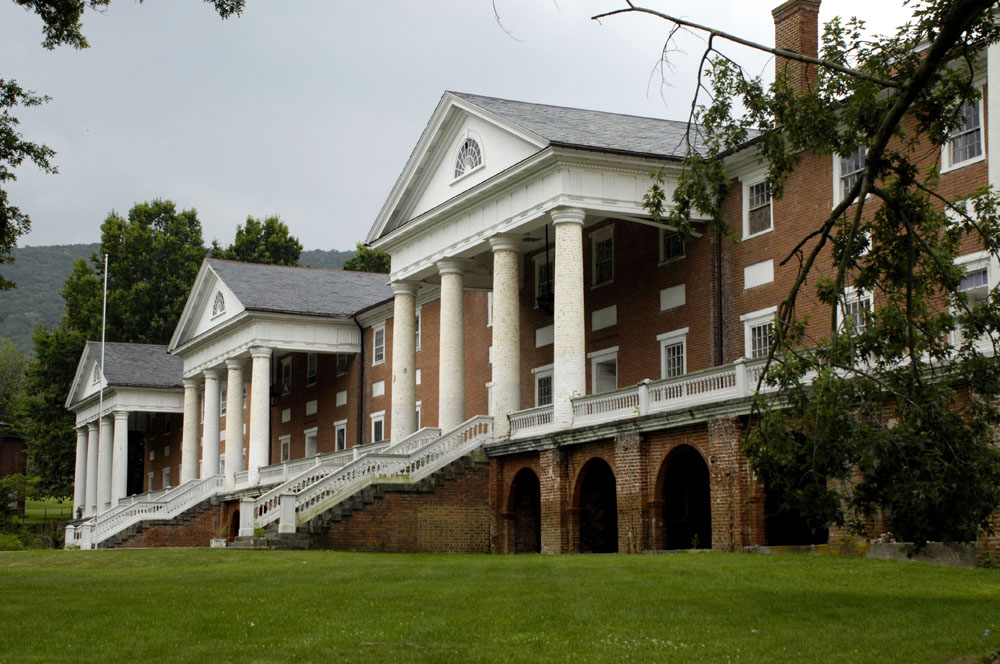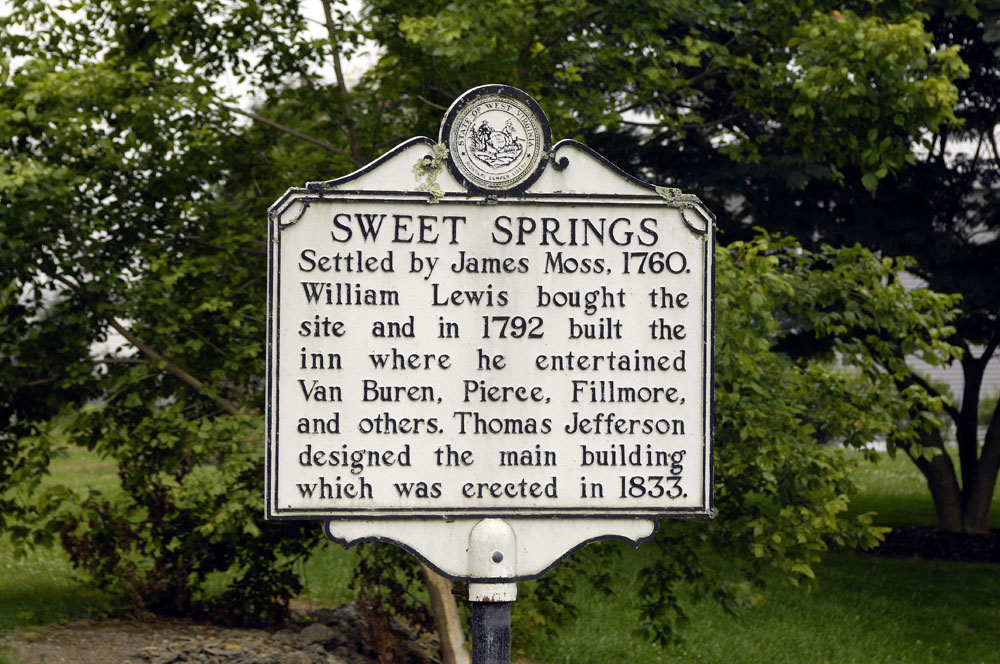The most recent dump from the game camera caught a young buck in broad daylight — no surprises there, though I’ve never seen a buck near the house. The camera also caught a hawk walking in the woods like a chicken. I have no idea what caught its interest on the ground.
Tomato sandwiches, all home made
The garden is producing beautiful tomatoes in generous quantities. Who can resist tomato sandwiches? Though I bought a loaf of bread for the ceremonial first tomato sandwich of the summer, I just couldn’t eat any more bad bread. This is organic sandwich bread made from a recipe in Peter Reinhart’s The Bread Baker’s Apprentice, the best book on breadmaking I’ve ever seen.
Home-grown organic tomatoes, homemade bread, and homemade pickles. You can’t go wrong.
The penalty for stealing eggs: Move down to the river
Every summer, black snakes stake out the territory near the chicken house and steal eggs. When Ken is here, they don’t get away with it. This snake was the second egg-stealing snake that Ken has caught this summer and moved to the river. He catches ’em, puts ’em in a bucket, and releases them down near the Dan River.
What planet did you say you’re from?
The crazy is bottom up, not top down
I have no idea what Fox-watchers and Limbaugh listeners are being told — probably the usual stuff about Benghazi and whatever it takes at the moment to keep Republicans angry, disinformed, and motivated to vote. But it’s pretty clear now that the mainstream media have fully realized that Donald Trump is a dangerous madman and that the possibility of his being elected president is an existential threat to the United States (if not to the world, if Trump gets his hand on the button).
All that is true. But there is one very important thing that the mainstream media and its pundits still are not acknowledging. That is that Donald Trump is not the source of the political insanity that has long been evident in this country, not just during this campaign. The political insanity is in the Republican Party itself and in the media that feed, inflame, and constantly deceive Republican voters. When you understand that this is bottom up, not top down, then it’s clear that only a crazy man like Trump could have gotten the Republican nomination in the first place. It’s also clear that the implosion of Trump’s campaign, though it will head off the present emergency, will not solve the problem that makes this country half insane and almost ungovernable.
We might hope that the younger sons of Rupert Murdoch might have plans for Fox News that would bring an end to the 24/7 paranoia and deception that has been fed to Republican voters for the past 18 years under Roger Ailes and which has made many, if not most, Republican voters delusional and driven by rage and paranoia. But we can’t count on it. Rush Limbaugh’s career will eventually end. But we have no idea when.
With the Dumpster fire of Donald Trump’s campaign safely behind us, we might imagine that we’d be out of the woods. But we would not be out of the woods. Nothing but the destruction of the Republican Party as it is today, a total reform of its pundits, mass firings at right wing “think tanks,” and calling out the meanness of some churches and theologies would ensure that we’re really out of the woods.
Below: Just one day’s worth of Trump headlines from the Washington Post.
Also:
Update 6:30 p.m. Aug. 4:
For some graphic evidence that the crazy is bottom up, have a look at this New York Times video from Trump rallies. If you’ve ever been verbally assaulted by a right-winger, you know that they get their words from the right-wing media, because they don’t have the knowledge or intellect to come up with their own. But the crazy, and the hatred, were already there before someone like Trump or Limbaugh put words in their mouths.
Road trip to Green Bank
I’ve made some fine road trips in my day, in several countries. But I believe the road trip that I just returned from was one of the best ever. The trip was mostly on back roads from Stokes County, North Carolina, through the Blue Ridge Mountains into the New River Valley, thence into West Virginia to Green Bank.
My primary mission was to see the Green Bank radio telescope, the largest fully steerable radio telescope in the world. To go see the telescope seemed like a no-brainer, since it’s not that far away and since I’m a space nerd and a radio nerd. Getting there was half the fun.
I am not well traveled in West Virginia. We all know that parts of West Virginia are environmental sacrifice zones, chiefly for coal but also for natural gas. This road trip took me through a very different part of West Virginia — a still-natural and well-preserved countryside, much of it in national forests.
The wildflowers! The trip would have been worthwhile for the wildflowers alone. The roadsides and pastures were dense with wildflowers at the peak of summer. I was green with envy at the rainfall the area has had and how green everything was. In between the mountains, the ridges of which tend to run north to south, are wide valleys, extremely fertile. It’s perfect pasture land. And, judging from the size of the farmhouses, that pastureland made lots of farmers rich. These are not the small subsistence farms that were much more common in the American southeast.
Morning temperatures ranged from 68 to 75 degrees F. Afternoons might have been warmer except that clouds and showers seem to descend on the area pretty much every summer day. There was hardly any traffic on the roads. I drove with the windows down, enjoying that sense of freedom (in my Smart car) that car commercials always try to give — the idea that there’s no one on the road but you. The road trip was almost freeway-free. GPS did the navigating, but when presented with alternate routes I always chose the routes that followed rivers or that avoided populated areas.
The telescope is fascinating. I have been plotting the third book of the Ursa Major series, and in book 3 Jake and Phaedrus actually will find themselves at Green Bank, having gotten there by mule, for some action scenes that require the use of the telescope, though the telescope had been idle since the calamity struck (in the first novel) that wiped out 6 billion of the earth’s population and returned the survivors to the Iron Age.
The telescope is extremely sensitive to radio interference. It’s located inside the National Radio Quiet Zone, and the surrounding mountains also keep out radio interference. I lost my cellular signal 50 miles south of Green Bank. Upon arriving in Green Bank, hoping to find accommodations to spend the night there (there are no such accommodations), I stopped at the public library, hoping to use WIFI. They library staff told me that they’re not permitted to have WIFI because it would interfere with the telescope. If you visit Green Bank, try to arrive early in the day, do the tour, and then leave yourself time to head east toward Charlottesville or south toward Blacksburg, if you want something to eat or a place to sleep — or Internet access.
The tour takes an hour. You’ll start in the auditorium with an undemanding scientific briefing from your tour guide, and then a video. Then you’ll board a bus and be driven to a point near the base of the telescope. The tour guide will explain that the bus uses a diesel engine, because the spark plugs in a gas engine would create radio interference.
It’s hard from photographs to grasp the scale of the telescope. It’s 485 feet tall, 60 percent higher than the Statue of Liberty. The size of the dish is almost three acres. It weighs 8,500 tons, but it can be rotated and tilted (azimuth and elevation) with extreme precision.
There were nine people in the tour group I was in. Six of them were Dutch, two were British, and I was the only American. Why are Americans so incurious? Once again I was reminded why I have so often said that I have much more in common with the average European than with the average American. I returned to Trump country — Wytheville, Virginia, to spend the night.
Driving south toward Wytheville, about an hour from Green Bank, I got cellular service again. A text message arrived from Ken, who was holding down the fort at the abbey: “Four foot long snake has been relocated. Raccoons ate all orchard apples. Lily is well. .15 Inches rain. Hope you’re having fun.”
Wytheville was not much fun, to tell you the truth. Wytheville was once a sleepy place, but major new roads have turned it into a travel hub. Watching an ill-mannered, incredibly unhealthy bunch of Americans descend on a free Ramada Inn breakfast made me want to emigrate to Scotland as quick as I could pack my bags. I was conflicted about where to have dinner in Wytheville. The many restaurants were mostly about “family” food, or they were chain restaurants. I finally settled on the Sagebrush Steakhouse & Saloon. It appeared to be locally owned, and I liked the “saloon” part of the name. I confess that I had a filet mignon with garlic mashed potatoes and broccoli. It was superb. I felt as though I was having supper in a well-run Irish pub. If you ever find yourself in Wytheville, I recommend it.
Places like Fries, Virginia, are depressing. Fries is a classic example of a textile town that is now poor, culturally and otherwise. In other words, Trump country. In 1940, its population was 1,555. It’s now 469. Years ago, most of the people worked in the cotton mill, which was powered by a hydroelectric dam on the New River. The dam is still there; the old mill has been demolished. The mill closed in 1989 and put 1,700 people out of work. The roads around Fries are a classic, and depressing, example of Trump-supporter impoverishment. The housing is dilapidated, with junk in the yards and dogs on chains. The nasty little churches seem to be the few remaining businesses. One of the churches even seemed aware of the fact that it’s just a business selling heavenly comfort into the squalor. “Under same management for over 2,000 years,” said the church’s sign out front. Harrumph.
But how different the economy of West Virginia used to be! Not only were there prosperous farmers living on fertile land, there were many resorts, most having to do with springs. The grandest resort I saw was Sweet Springs, designed by Thomas Jefferson and once a hangout of the rich and famous.
Upon arriving home, I said to Ken that the road trip put me in mind of thoughts he describes in Trespassing Across America. Ken uses much more refined and nuanced language, but this road trip made me both love and hate America. Wonders such as the Green Bank Telescope are a reminder of what Americans have accomplished. Sweet Springs — not to mention those beautiful farms and the national forest — is a reminder of what America once was and promised to be. But now there are Trump signs amid the ruins of our old economy. As for the new economy in places this remote, it appears mostly to have to do with big highways and the sublimely ugly service and retail development that springs up along those highways. A brush with Europeans is a reminder of just how ignorant and culturally impoverished most Americans are.
You know what I think would make this country great again? An educated and informed population, the opposite of what Donald Trump and his political party stand for. I got the heck out of Fries and Wytheville and hurried back to the abbey, a tiny Fox-free bubble of books and imagination in the foothills.
So why will Jake and Phaedrus find themselves at Green Bank in book 3 of the Ursa Major series? A calamity threatens — an act of sabotage that would destroy an incoming ship loaded with E.T. VIP’s from the galactic federation. Unless Jake and Phaedrus can succeed in transmitting a radio signal out to the vicinity of Neptune to prevent the detonation, earth will get itself into yet another deep pickle, as earth is wont to do.

The tour guide uses a Faraday cage and a spectrum analyzer to show how even a digital camera can create radio interference.

The nicest of the many churches I passed

What else is new? Outside money is always seeking to turn what’s left of natural America into a sacrifice zone.
New game camera!
All the neighbors have game cameras. So it seemed like a no-brainer for the abbey to have one, too, to learn more about the many wild critters who live here. On its first night, the camera was set up for deer, but no deer showed up. Instead there were only shots of Ken setting up the camera and retrieving the memory card, while bringing a tomato from the garden.
I’ll post photos from the game camera when there are good ones.
Pickling day
I wanted to make some no-heat, no-cook pickles to be eaten within the next few weeks as opposed to being preserved for the winter. This is an easy process, because the canning process is unnecessary — there is no need to use a water-bath canner or a pressure cooker. I also wanted to ferment some pickles naturally without using vinegar.
The abbey garden is providing cucumbers for the table, but not enough for putting up pickles. So I bought half a bushel of beautiful fresh-picked cucumbers from a farmer who lives just north of here. The cost was $15 for the half bushel.
To further reduce the amount of work, I used half-gallon wide-mouth jars. For about two hours’ work, I ended up with three gallons of pickles.
Two gallons of the pickles involved nothing more than a vinegar solution poured over the packed pickle jars, with some spices. They should be ready to eat in two or three days. The process for the fermented pickles is to fill the jars with brine on top of the packed cucumbers, spices, and a few grape leaves. They’ll take a month or so to ferment before they’re ready to eat. I used airlock caps that I bought from Amazon. The airlock caps allow fermentation gases to escape but keep outside air from getting in, reducing the risk of mold.
Though pickle cucumbers are supposed to be able to take the heat of the canning process, still I like the idea of pickles that have never been heated. They should be nice and crisp.
Why is Ailes’ head on the block?
So Roger Ailes, an evil genius whose genius and whose evil can be topped by few (other than Dick Cheney), is being escorted out of Fox News. The cover story is that Ailes’ departure (which sounds like a firing) has something to do with sexual harassment. Horse. Wash. The right-wing money and billionaire money behind Fox News couldn’t care less about a little old sexual harassment case as long as Ailes delivers what his bosses want. Corporations routinely buy their way out of sexual harassment cases. It’s just a cost of doing business. Ailes is a pig, and everyone always has known that Ailes is a pig. Something else is behind his firing. What might that be?
We can only speculate and hope for future leaks. But my guess is that the vast right-wing conspiracy is plenty pissed off about what has been happening. Roger Ailes’ job was to help make money for his billionaire owners, to keep the clueless, white, right-wing voters angry, deceived, and paranoid, and to keep them under control. That’s where Ailes failed spectacularly. He grew Fox News. He kept the white idiocracy inflamed and angry. But he failed to control them. Failing to control them not only allowed Donald Trump to get the Republican presidential nomination, it also has threatened the very future of the Republican Party and broke the puppet strings that tie the white idiocracy to the billionaires who expect, for their investment, to set the agenda and get total political control of the country through a preferably legal election. They must be incredibly pissed off, because this election may well cost the right-wing elite not only the White House for another eight years but also control of Congress as well. They stand to lose control of the Supreme Court pretty much forever.
But right-wing billionaires always have a plan. Fox News’ 24/7 paranoia-mongering, hate-mongering, and keeping its target audience completely distracted and deceived is absolutely critical to the right-wing plan, whatever that plan is. That plan may now be starting to unfold, with the firing of Ailes as one of the first steps.
In the coming days and weeks, we need to pay careful attention to changes at Fox News. As usual, pay no attention to what they’ll say about Ailes’ departure and the selection of his replacement. That will be a lie and a cover story, as always. Rather, pay attention to what they do, while deconstructing their cover stories for clues to what they’re trying to distract us from. Changes at Fox News may be the first real clues we get to how the right-wing elite are retooling for a new strategy, now that the old has blown up in their ugly faces.
Update, July 30, 2016: In an interview with Slate magazine, Gabriel Sherman, who wrote an unauthorized biography of Roger Ailes, talks about what he thinks is going on inside Fox news. Here’s the link and a quote: “My sense is that they are not going to just rip the place up before November. But I think they will be watching the political landscape in America as the election unfolds. They have people right now looking at how they are going to reposition this network for a post-2016 landscape.”
Chicken crimes
I had been watching the first tomato for weeks, ever since it was the first bloom. Just two days ago, it had started turning red. It was to go into the ceremonial first tomato sandwich of the summer. But, this morning, Sophia the chicken followed me into the garden through a gate that I had left open. The chickens are not allowed into the garden during garden season. Her chicken eye immediately spotted the red, and my gardener eye immediately spotted Sophia making for the tomato. Before I could head her off, she had taken a bite.
Tomato number 2 will make the first sandwich, and the remains of tomato number 1 will go into a curry.


